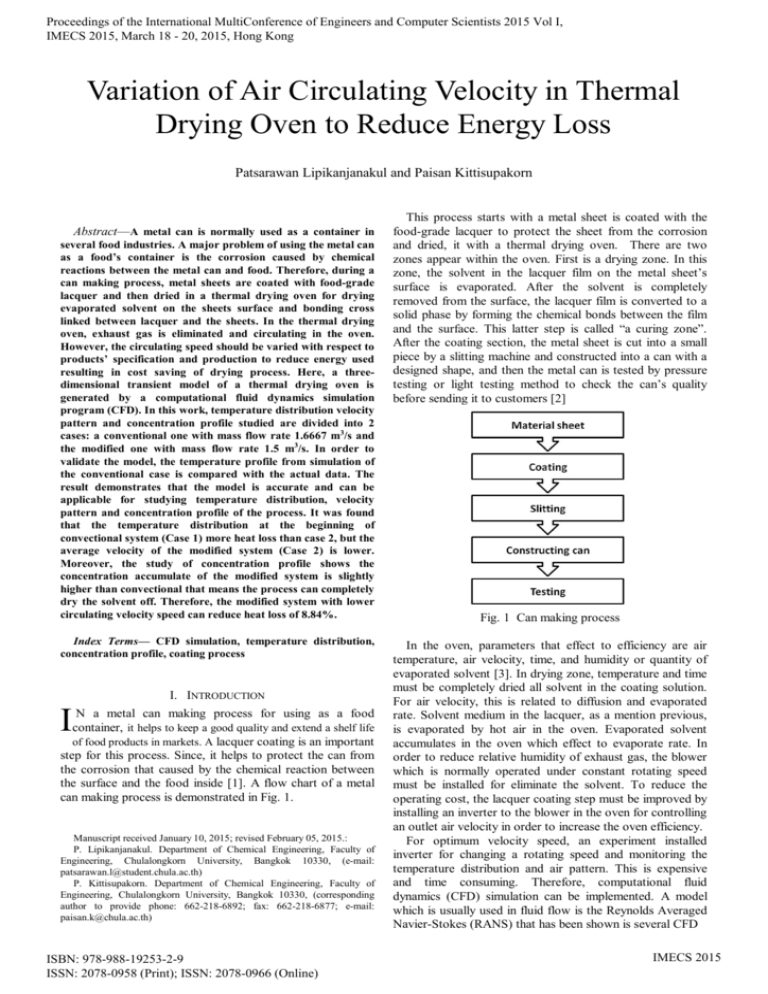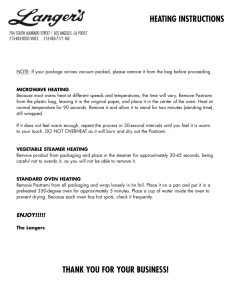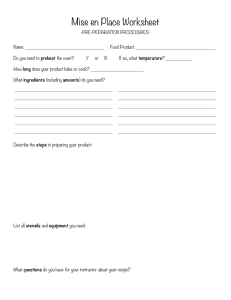
Proceedings of the International MultiConference of Engineers and Computer Scientists 2015 Vol I,
IMECS 2015, March 18 - 20, 2015, Hong Kong
Variation of Air Circulating Velocity in Thermal
Drying Oven to Reduce Energy Loss
Patsarawan Lipikanjanakul and Paisan Kittisupakorn
Abstract—A metal can is normally used as a container in
several food industries. A major problem of using the metal can
as a food’s container is the corrosion caused by chemical
reactions between the metal can and food. Therefore, during a
can making process, metal sheets are coated with food-grade
lacquer and then dried in a thermal drying oven for drying
evaporated solvent on the sheets surface and bonding cross
linked between lacquer and the sheets. In the thermal drying
oven, exhaust gas is eliminated and circulating in the oven.
However, the circulating speed should be varied with respect to
products’ specification and production to reduce energy used
resulting in cost saving of drying process. Here, a threedimensional transient model of a thermal drying oven is
generated by a computational fluid dynamics simulation
program (CFD). In this work, temperature distribution velocity
pattern and concentration profile studied are divided into 2
cases: a conventional one with mass flow rate 1.6667 m3/s and
the modified one with mass flow rate 1.5 m3/s. In order to
validate the model, the temperature profile from simulation of
the conventional case is compared with the actual data. The
result demonstrates that the model is accurate and can be
applicable for studying temperature distribution, velocity
pattern and concentration profile of the process. It was found
that the temperature distribution at the beginning of
convectional system (Case 1) more heat loss than case 2, but the
average velocity of the modified system (Case 2) is lower.
Moreover, the study of concentration profile shows the
concentration accumulate of the modified system is slightly
higher than convectional that means the process can completely
dry the solvent off. Therefore, the modified system with lower
circulating velocity speed can reduce heat loss of 8.84%.
Index Terms— CFD simulation, temperature distribution,
concentration profile, coating process
I. INTRODUCTION
I
N a metal can making process for using as a food
container, it helps to keep a good quality and extend a shelf life
of food products in markets. A lacquer coating is an important
step for this process. Since, it helps to protect the can from
the corrosion that caused by the chemical reaction between
the surface and the food inside [1]. A flow chart of a metal
can making process is demonstrated in Fig. 1.
Manuscript received January 10, 2015; revised February 05, 2015.:
P. Lipikanjanakul. Department of Chemical Engineering, Faculty of
Engineering, Chulalongkorn University, Bangkok 10330, (e-mail:
patsarawan.l@student.chula.ac.th)
P. Kittisupakorn. Department of Chemical Engineering, Faculty of
Engineering, Chulalongkorn University, Bangkok 10330, (corresponding
author to provide phone: 662-218-6892; fax: 662-218-6877; e-mail:
paisan.k@chula.ac.th)
ISBN: 978-988-19253-2-9
ISSN: 2078-0958 (Print); ISSN: 2078-0966 (Online)
This process starts with a metal sheet is coated with the
food-grade lacquer to protect the sheet from the corrosion
and dried, it with a thermal drying oven. There are two
zones appear within the oven. First is a drying zone. In this
zone, the solvent in the lacquer film on the metal sheet’s
surface is evaporated. After the solvent is completely
removed from the surface, the lacquer film is converted to a
solid phase by forming the chemical bonds between the film
and the surface. This latter step is called “a curing zone”.
After the coating section, the metal sheet is cut into a small
piece by a slitting machine and constructed into a can with a
designed shape, and then the metal can is tested by pressure
testing or light testing method to check the can’s quality
before sending it to customers [2]
Fig. 1 Can making process
In the oven, parameters that effect to efficiency are air
temperature, air velocity, time, and humidity or quantity of
evaporated solvent [3]. In drying zone, temperature and time
must be completely dried all solvent in the coating solution.
For air velocity, this is related to diffusion and evaporated
rate. Solvent medium in the lacquer, as a mention previous,
is evaporated by hot air in the oven. Evaporated solvent
accumulates in the oven which effect to evaporate rate. In
order to reduce relative humidity of exhaust gas, the blower
which is normally operated under constant rotating speed
must be installed for eliminate the solvent. To reduce the
operating cost, the lacquer coating step must be improved by
installing an inverter to the blower in the oven for controlling
an outlet air velocity in order to increase the oven efficiency.
For optimum velocity speed, an experiment installed
inverter for changing a rotating speed and monitoring the
temperature distribution and air pattern. This is expensive
and time consuming. Therefore, computational fluid
dynamics (CFD) simulation can be implemented. A model
which is usually used in fluid flow is the Reynolds Averaged
Navier-Stokes (RANS) that has been shown is several CFD
IMECS 2015
Proceedings of the International MultiConference of Engineers and Computer Scientists 2015 Vol I,
IMECS 2015, March 18 - 20, 2015, Hong Kong
TABLE II
BOUNDARY CONDITION
Fig. 2 Geometry of the oven
studied, for example a three-dimensional geometry
simulation of a heating oven with natural air circulation [45], and bakery oven or bread breaking oven [6-7] etc.
This work aims to investigate the effect of the outlet air
velocity on the air velocity pattern, temperature distribution
in the drying zone and the concentration of evaporated
solvent in the thermal drying oven by using a computational
fluid dynamics simulation program (CFD) based on a threedimensional time dependent heat transfer model with nonisothermal flow. The results from this program are validated
with the real plant data to guarantee the correction of the
models. In addition, this work is divided into two case
studies. Case 1 is studied with the outlet air flow rate equals
to 1.6667 m3/s (Conventional system) and case 2 is studied
with the outlet air flow rate equals 1.5 m3/s (Modified
system).
Boundary
Surface*
Initial temperature condition
(K)
Mass flow rate (m3/s)
Normal velocity inlet (m/s)
Normal velocity inlet (m/s)
Normal velocity outlet (m/s)
Temperature inlet (K)
Temperature inlet (K)
Temperature inlet (K)
Pressure (bar)
Outlet velocity
Outflow temperature
Symmetry heat and flow
Interior wall
Thin thermal resistive layer
Convectional heat flux
(b)
(c)
(d)
(b)
(c)
(e)
(e)
(e)
(d)
(a)
(i)
(i)
(f),(g),(h)
Case
Case
1
2
303.1500
1.6667 1.5000
0.1584 0.1584
0.6223 0.5498
4.2104 3.7893
473.1500
453.1500
303.1500
101314.9978
* Surface boundary shown in Fig. 2
III. MATHEMATICAL MODEL
The model of this work is based on the Reynolds
Averaged Navier-Stokes equation (RANS) [8] which is
divided into 3 models; velocity model, temperature model,
and concentration model. All models are conservative
equations in Cartesian coordinate with time dependent. The
values of parameter that use in this work are summarized in
Table 1.
A. Velocity model and temperature model
The velocity and temperature models in this work are nonisothermal flow models. The general form of these models
including with the conservation equations of mass,
momentum and energy are shown as follow;
II. OVEN CONFIGURATION
This work based on a continuous indirect-fired oven that
uses in a real plant. The CFD geometry of this oven shows in
Fig. 2. The oven’s dimensions are 1.2975 m width, 2.095 m
height and 5.1 m length. Since, the oven’s dimension is
symmetry then the width of this oven can be reduced by a
half of its width for using in the simulation section.
In Fig. 2, surface (a) is symmetry surface for temperature
and air velocity. Surface (b) is an air inlet duct with a cross
sectional area 0.292 m along the length of the oven. Surface
(c) shows an interface area of drying and curing zone. The
semi-circle (d) is air outlet surface with 0.602 m in diameter.
It is located at 1.435 m from the entrance of the oven by
surface (e). The walls of the oven are shown as the surface
(f), (g), and (h). Surface (i) which are located in the oven
represent the metal sheets (0.01 m × 0.005 m). Each sheet is
inclined at an angle 10 degree from z-axis.
The equation of mass conservation
( u ) 0
t
(1)
The equation of momentum conservation
u
u u p F
t
(2)
The equation of energy conservation
TABLE I
THE TEMPERATURE DEPENDENT PHYSICAL PARAMETERS OF ETHYLENE GLYCOL BUTYL ETHER [9]
Parameter
Function
Density
Ideal-gas
2
Heat capacity
Thermal conductivity
Viscosity
699.9
1959.9
C p 118380 232700
172000
1
1
T
sinh
(699.9
T
)
T
cos
h
(1959.9
T
)
1.87 107 T 0.9407
k
1 704T 1
3.66 108 T 0.90894
ISBN: 978-988-19253-2-9
ISSN: 2078-0958 (Print); ISSN: 2078-0966 (Online)
(kg/m3)
Tmax
(K)
-
Tmin
(K)
-
(J/kmol∙K)
298.15
1500
(kW/m∙K)
444.47
1000
(kg/m∙s)
199.17
1000
Unit
2
IMECS 2015
Proceedings of the International MultiConference of Engineers and Computer Scientists 2015 Vol I,
IMECS 2015, March 18 - 20, 2015, Hong Kong
C p
T
C pu T kT Q Qvh Wp
t
(3)
From equation (2), the viscous force (τ) can be presented
by
2
u u T u
3
t
(4)
The eddy viscosity (µT) in (4) can be calculated by the
turbulence model. The standard k-Ɛ turbulence flow model
appropriates for flow in complex geometry [5-7]. This model
consists of two equation are turbulence kinetic energy (k)
and viscous dissipation (Ɛ). These following equations
written in:
t
t
u T Pk
k
u T
C 1
k
(5)
k
Pk C 2
2
(6)
k
Where,
T C
2
(7)
t
Pk T u ∶ u u
Fig. 3 Temperature distribution (A) Case 1 and (B) Case
2
2
2
u k u
3
3
(8)
To consider the problem, the boundary conditions for
calculating are listed in Table II and the value of adjustable
constants (Cµ, σk, σε, Cε1, and Cε2) are 0.09, 1.00, 1.30, 1.44,
and 1.92, respectively [10].
In this work, either velocity model or temperature model is
simulated by using COMSOL simulation multiphysics
(version 4.3b). The mesh geometry was generated in free
tetrahedral. The generated mesh numbers are 777270 domain
elements, 57043 boundary elements, and 5713 edge
elements. The simulation study has been made based on
computer with windows 7 64-bit 3.0 GHz Inter core i5 CPU
and 16 GB RAM.
Fig. 4 Average temperature profile along the length
TABLE III
FUNCTION OF TEMPERATURE AND VELOCITY ALONG THE LENGTH
Parameter
Case
Temperature
(K)
Velocity
(m/s)
Case 1
Case 2
Case 1
Case 2
Function
-0.2925x6 + 4.726x5 - 29.773x4 + 95.218x3 - 176.63x2 + 213.02x + 312.17
-0.331x6 + 5.5524x5 - 36.649x4 + 122.85x3 - 230.06x2 + 252.29x + 313.11
0.1469x4 - 0.6918x3 + 0.8461x2 + 0.0999x + 0.3243
-0.0132x5 + 0.1998x4 - 1.1733x3 + 3.3331x2 - 4.5671x + 3.1343
0.0863x4 - 0.5245x3 + 0.8415x2 - 0.0994x + 0.3632
-0.0146x6 + 0.2707x5 - 2.0459x4 + 8.0803x3 - 17.601x2 + 20.094x - 8.7019
R-square
0.9845
0.9794
0.9943
0.9719
0.9951
0.9924
Length Range
Min
Max
0.0
5.1
0.0
5.1
0.0
2.0
2.0
5.1
0.0
2.0
2.0
5.1
x is length of the oven (m)
ISBN: 978-988-19253-2-9
ISSN: 2078-0958 (Print); ISSN: 2078-0966 (Online)
IMECS 2015
Proceedings of the International MultiConference of Engineers and Computer Scientists 2015 Vol I,
IMECS 2015, March 18 - 20, 2015, Hong Kong
Fig. 6 Velocity pattern in the oven
Fig. 5 Temperature comparison between simulation and
measurement
The result from the temperature model is validated with
the data that collected from a real plant to ensure the
correction of the model. The validation points of temperature
along the oven are measuring 3 points. The first point is the
bottom of plate by 0.08 m × 0.08 m distance from corner.
The middle of plate is a second point. For last point is on the
top of the plate.
B. Concentration model
These concentration models are calculated by using
MATLAB software and the value of parameters that use for
calculation are obtained by the simulation results in the
COMSOL software from previously section. The general
form of the concentration model is shown in (9) that combine
with evaporation rate [11]
C
u C j N a
t
Fig. 7 Average velocity along the oven
(9)
Where,
j abC
AB
(10)
4.14 104 T 1.9 1/ MWA 1/ MWB MWA0.33
p
Na kc C
(11)
(12)
Fig. 8 Evaporated rate along the oven
These concentration models are calculated by using
MATLAB software and the value of parameters that use for
calculation are obtained from the simulation results in the
COMSOL software.
IV.
RESULT AND DISCUSSION
A. Temperature distribution and profile
The comparison of temperature distribution in case 1
(Conventional system with the outlet air flow rate equals
1.6667 m3/s) and case 2 (Modified system with the outlet air
flow rate equals 1.5 m3/s) at steady state is illustrated in Fig.
3. From this figure, the temperature distribution in case 1 at
Fig. 9 Concentration along the oven
ISBN: 978-988-19253-2-9
ISSN: 2078-0958 (Print); ISSN: 2078-0966 (Online)
IMECS 2015
Proceedings of the International MultiConference of Engineers and Computer Scientists 2015 Vol I,
IMECS 2015, March 18 - 20, 2015, Hong Kong
the entrance zone is lower than the distribution in case 2
because the average velocity in case 1 is greater than case 2,
so more heat escape to surround. After that, temperature of
both cases rapidly goes to control temperature at around 543
K.
For the average temperature along the oven is illustrated
in Fig. 4. It can be seen that the temperature at the 0.5 m to
2 m, case 2 is higher than case 1 seeing that case 1 is more
convective heat transfer to the outlet surface. Then, almost
steady around 2.3 m at 453 K. At the outlet surface (b) in
Fig. 2 of case 1 and case 2 are 423.1647 and 428.6035,
respectively at steady state that saving heat loss around
8.84%.
Fig. 5 demonstrates that the temperature models can be
used for calculation in the next section because it has a
slightly different between the simulation result and the real
data by less than 5%. This difference may be occurred from
the error when collected the real data and simulation by
assumed that sheets are not moving.
B. Velocity distribution
The velocity pattern at steady state is illustrated in Fig. 6.
The both cases are insignificant difference at same model and
boundary condition. Moreover profiles of average velocity
along the system, both cases are similar trend as presented in
Fig. 7. The maximum velocity occurs at the outlet surface of
both cases. At the beginning velocity of case 1 is higher than
case 2. For a peak around five meters length from the
entrance, it is observed no plate around this section due to
grid mesh problem that effect of the turbulence parameter, so
velocity around this area is higher.
C. Concentration profile
For simulation the concentration model, the temperature
and velocity functions are demonstrated in Table III by
assume that the velocity and temperature is independent on
time (at steady state).
The evaporation rate at steady state is illustrated in Fig. 8.
The evaporation rate is mainly related to the air
concentration, and then this rate is the greatest at the
beginning due to less evaporated solvent in air and after that
decrease until the evaporated solvent is run out. In the case
1, the evaporation rate is greater than case 2 because velocity
is higher that related to convection term.
For concentration profile, evaporated rate is the main
effect parameter of concentration model, then concentration
is rapidly increase as shown in Fig. 9 due to result of
evaporation rate. Comparison of case 1 and case 2, the trend
are same but case 2 has an average concentration slightly
higher than case 1 which means more accumulate solvent in
the oven, but it not much effect to evaporation rate.
V. CONCLUSION
A three-dimensional CFD model of the transient heat
transfer in a thermal drying oven is generated by using nonisothermal model. The temperature profile from simulation is
compared with actual data to ensure the precision of the
model and it shows that the model can be used for predicting
concentration profile.
ISBN: 978-988-19253-2-9
ISSN: 2078-0958 (Print); ISSN: 2078-0966 (Online)
From the simulation results of temperature and velocity,
the accumulated concentration in a modified system with an
inverter (Case 2) is higher than that in a conventional system
(Case 1) but it helps to reduce the heat loss in the drying
zone by 8.84%.
APPENDIX
NOMENCLATURE
Cp
Cµ
Cε1
Cε2
Cα
F
g
jα
k
kc
MWα
Na
p
Pk
Q
Qvh
t
T
u
Wp
x
y
z
specific heat capacity at constant pressure (J/(kg·K))
turbulence model parameter
turbulence model parameter
turbulence model parameter
concentration of species α (kg/m3)
volume force (N/m3)
gravity force (m/s2)
mass flux (kg/(m2·s))
thermal conductivity (W/(m·K))
(m/s)
molecular weight of species α (kg/mol)
evaporation flux rate (kg/(m2·s))
pressure (kg/(m·s2))
Production rate of turbulence kinetic energy
(J/(m3·s))
contains the heat sources (W/m3)
viscous heating (W/m3)
time (s)
absolute temperature (K)
velocity vector (m/s)
pressure work (W/m3)
distance of Cartesian coordinate in x axis (m)
distance of Cartesian coordinate in y axis (m)
distance of Cartesian coordinate in z axis (m)
Greek symbols
αAB
binary diffusion for system A-B (m2/s)
ε
turbulence dissipation (J/kg)
κ
turbulence kinetic energy (J/kg)
ρ
density (kg/m3)
τ
viscous stress tensor (kg/(m·s2))
µ
viscousity (kg/(m·s))
µT
eddy viscosity (kg/(m·s))
σk
turbulence model parameter
σε
turbulence model parameter
Subscripts
x
index of Cartesian coordinate in x axis
y
index of Cartesian coordinate in y axis
z
index of Cartesian coordinate in z axis
Mathematic operations
δ
unit tensor
del operator
IMECS 2015
Proceedings of the International MultiConference of Engineers and Computer Scientists 2015 Vol I,
IMECS 2015, March 18 - 20, 2015, Hong Kong
ACKNOWLEDGMENT
The financial support to this work under The
Institutional Research Grant (The Thailand Research Fund),
IRG 5780014, and Chulalongkorn University, Contract No.
RES_57_411_21_076
REFERENCES
B. Othenin and Y. Pelletier, “Metallic containers for Sterilization,” in
Food packaging technology, vol. 1 G. Bureau & J.-L. Multon Ed,
U.S.A.: WILEY-VCH. 1996, pp. 203-219.
[2] E.P. Degarmo, J.T. Black, and R.A. Kohser, Materials and Processes
in Manufacturing, Wiley, 2003
[3] E. Blotta, V. Balları, M. Brun, and H. Rabal, “Evaluation of speckleinterferometry descriptors to measuring drying-of-coatings,” Journal of
Signal Processing, 91, pp. 2395–2403.
[4] V.P.C. Mohan, and P. Talukdar, “Three dimensional numerical
modeling of simultaneous heat and moisture transfer in a moist object
subjected to convective drying,” International Journal of Heat and
Mass Transfer, 53, pp. 4638-4650.
[5] J. Smolka, Z. Bulinski, and A.J. Nowak, “The experimental validation
of a CFD model for a heating oven with natural air circulation,”
Journal of Applied Thermal Engineering, 54, pp. 387-398.
[6] M. Boulet, B. M. MarcosDostie, and C. Moresoli, “CFD modeling of
heat transfer and flow field in a bakery pilot oven,” Journal of Food
Engineering, 97, pp. 393–402.
[7] M. Boulet, B. Marcos, M. Dostie, and C. Moresoli, “CFD modeling of
heat transfer and flow field in a bakery pilot oven,” Journal of Food
Engineering, 97, 393–402.
[8] R.B. Bird., W.E. Stewart, and E.N. Lightfoot, Transport phenomena,
2nd ed., John Wiley and Sons, Inc., 2007, ch 1,3,11.
[9] C.L. Yaws, Chemical propertiea hand book. New York: MC GrewHill, 1999, ch 1-2, 21, 23.
[10] H.K. Versteeg, and W. Malalasekera, An Introduction to
Computational Fluid Dynamics, 2 ed. Englant: Pearson prentice hall,
2007, ch. 3.
[11] A.A. Hummel, K.O. Braun, and M.C. Fehrenbacher, “Evaporation of a
liquid in a flowing airstream,” American Industrial Hygiene
Association Journal, 57, pp 519–525, 1996.
[1]
ISBN: 978-988-19253-2-9
ISSN: 2078-0958 (Print); ISSN: 2078-0966 (Online)
IMECS 2015






